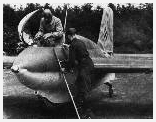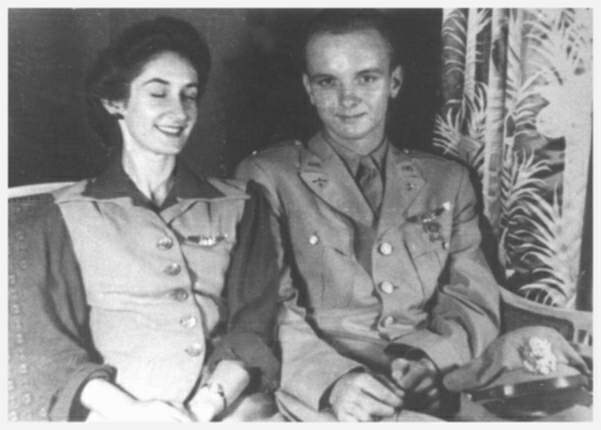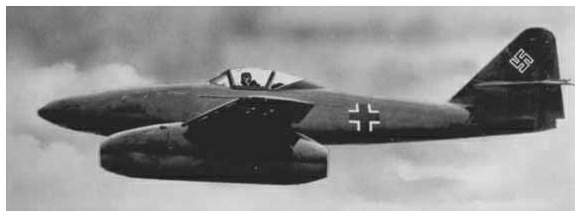 LT. DENIS J. ALISON
LT. DENIS J. ALISON
� � � During my visit to the Mighty Eighth Heritage Museum, in Savannah, Georgia, I had the chance to see one of the last few remaining Messerscmitt Me-163 Komet rocket planes left in existence. This aircraft had fascinated me since I first saw photographs of it when I was a child. Later I wrote to one of the test pilots of the Me-163, Rudi Opitz, who today is a glider instructor in New England at the age of 90. In his reply he stated that the reputation the aircraft had gained, that of being dangerous to fly, was not necessarily correct. While he had a few mishaps in the plane he still felt it was safe and easy to fly.  Rudi Opitz climbs into the cockpit of an Me-163 in this still from a wartime German propaganda movie. � � � A groundbreaking design, it was one of the German "wonder weapons" that the Luftwaffe used in a desperate, and fruitless, attempt to regain control of the European sky during the final months of the war. It also was arguably the most unusual warplane to ever see production and be used in action. The propellants used were highly volatile and many Komets were destroyed in explosions while still on the ground. Another problem was also encountered during landing. The aircraft did not have landing gear and took off from a reusable trolley, which was then jettisoned. It landed on a skid mounted below the fuselage. This little fighter was extremely fast, with a top speed that bordered on 600mph, and a rate of climb that was unmatched at the time (16,000 feet per minute.) It was also well armed, with 2 x 30 mm MK 108 cannons, which allowed German pilots to score several victories over Allied bombers. However, it was very vulnerable during landing, as it glided back towards the airfield unpowered.  The Me-163 at the Mighty Eighth Heritage Museum. � � � � � � I was reminded at the time of Lt. Denis Alison's final mission, on 1 November 1944, and how one of these wonder weapons (I later learned it was most likely an Me-262 Swallow) shot him down while he tried to escort a straggler B-24 back home. It struck me how sad it was that his life was lost in a war that would be over in just a handful of months.
 Denis Alison and his wife Barbara � � � Denis J. "Spike" Alison was born in Birmingham, Michigan. He was from a fairly wealthy family as his father was an investment banker and president of the Detroit Stock Exchange. The family had homes in both Detroit and Lapeer County. Denis married Barbara Cary just before he was shipped overseas. On 11 August, 1944 he was assigned to the 77th.FS/20th.FG at King's Cliffe, England. His brother Tom would serve with the U.S. Navy. � � � Alison took part in 20th.FG missions 161, 165, 166, 167, 168, 172, 173, 174, 175, 178, 180, 184, 186, 192, 193, 195, 200, 201 and 202. � � � The intelligence report for mission 202 reads in part: "Yellow Flight of the 77th.FS, flying at 32,000 ft., was bounced by an Me-262, a twin-unit German jet job. Capt. James Herbert led the flight in a hot pursuit toward the Zuider Zee and at about 1423, Lt. Flowers, pulling over 72 inches at 3,000 RPM closed on the jet in a broad turn and opened fire. He observed many strikes and a moment later the Me-262 pulled up sharply and the pilot bailed out. � � � "Just after the engagement began, Lt. Denis Alison (77th.) was missed fomr his number 4 position in Yellow Flight and was not heard from again. It is possible that the jet, on its pass through the formation, shot him down, though nothing can be said for certain." � � � Lt. Everett Jones, flying the lead B-24 for the 466th. Bomb Group had successfully struck the oil refineries at Gelsenkerschen and was returning to base. Trouble developed on one of the Liberator's four engines and he was forced to shut it down and descend to a lower altitude. � � � "The P-51 just suddenly appeared up off our right wing." Jones stated in an interview with the Dallas Morning News. "Then he was gone. It was almost instantaneous." � � � An aircraft dove down on the B-24 and its escort and opened fire on the P-51 before turning and disappearing into the clouds. "We had never seen a man-made object travel so fast." Jones recounted. "The P-51 went into all sorts of gyrations and tumbled out of the sky. I don't think he knew what hit him." � � � And neither did Jones, who upon landing enquired about the existence of an enemy rocket plane. He was told such planes did exist. He assumed that the aircraft that had knocked his escort out of the air had been one of these new rocket-propelled planes. He also wondered who the pilot of the Mustang that had come to aid them was and if he had survived. No chute had been seen as the P-51 fell earthward.
� � � Capt. James Herbert, flying lead of a four-plane flight of 77th.FS Mustangs recalled about the mission, "Somebody came on the radio and said that a Me-262 was trying to sneak up on a Mustang. I kicked my plane around, and I didn't see any jet trying to sneak up behind us. Ten to 15 seconds later, this 262 came right underneath my left wing. I could have spit in his cockpit." � � � Herbert called for his flight to follow and dove to give chase to the jet. The third man, Lt. Raymond Flowers and another pilot cut a circle inside of the other aircraft and managed to shoot out one of the jet's engins at about 16,000 feet. � � � It was then that the pilots noticed the absence of Lt. Alison. "Denis always lagged behind." Herbert stated." I had talked to him a number of times about trying to keep up." The flight returned to base without knowing Alison's fate. � � � The burgermeister, Wiefer Lieftucht, made a report that a P-51 had crashed and burned near Legden. The dog tags of the lifeless pilot identified him as Denis Alison. Arrangements were made and Alison was buried in the nearby Roman-Catholic churchyard. � � � Martin K�sters, a current resident of Legden and a researcher of World War 2 air battles said, "He was the only USAAF pilot who died here and he was buried next to R.A.F. crews. After the war his remains were moved together with the bodies of the other airmen to Reichswald war cemetery in Cleve. After this his remains were lost and have never been found again. In the 50�s there were investigations to find him and two of the graves at Cleve were opened, but the remains which were taken to examination center turned out to be those of two R.A.F. crew members, who were killed and originaly buried in Legden." � � � Jones and Herbert's paths would cross nearly 55 years later, as the Liberator pilot had never given up on finding the identity of the pilot who had come to the aid of his stricken aircraft. With the help of researchers he discovered Alison's identity and the Fighter Group he belonged to. He then contacted Herbert, Alison's flight leader that day, hoping for more information. He was informed that Alison's brother and several researchers had also been attempting to piece all of the story together. � � � Herbert believes that Alison tried to follow the rest of the flight in the dive as they chased the Me-262, but was too far behind. He then must have pulled out and noticed the lone Liberator flying close by. He pulled up to give the aircraft some cover and then the jet attacked. � � � Jones eventually uncovered all of the information he sought, however he is still convinced that a Me-163 rocket plane downed Alison. Records indicate, however, that none were operational in the skies over Germany on 1 Nov. 1944. � � � Lt. Denis J. Alison flew a total of 82 hours, ten minutes in combat with the 20th.FG. He was awarded the Air Medal with one cluster. At the time of this death he was flying a P-51 Mustang, serial #44 - 14378, coded LC - A, named "Hookin Bull."
|
MORE ON THE LOSS OF DENIS ALISON
RETURN TO THE 20TH.FG
(Komet photograph courtesy of The Art of Syd Edwards, Alison photograph courtesy of Martin K�sters)
Unless otherwise noted, all content � copyright The Art of Syd Edwards 1998-1999-2000. All rights reserved and reproduction is prohibited.

